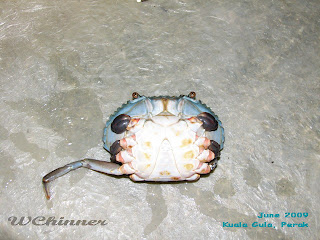When crabs grow larger, their shells or carapaces (or exoskeletons) will not be able to accommodate their sizes because their shells will not grow. They must remove the shells and grow a new and bigger ones. This process is known as molting. They molt the exteriors or exoskeletons and have soft coverings for a few days. At this stage, they are now soft-shell crabs until their soft coverings harden.
In the wild, molted crabs are vulnerable to predators such as stingrays, larger fishes or even fall prey to cannibalism. During this stage, molted crabs will normally find shelter from the predators by hiding in between rocks. That is why it is difficult to catch soft-shell crabs in the net.
Ever wonder how your deep fried crunchy soft-shell crabs made their way to the restaurants and then onto your plate? If you think these soft-shell crabs are caught wild, please allow me to enlighten you.
Ever wonder how your deep fried crunchy soft-shell crabs made their way to the restaurants and then onto your plate? If you think these soft-shell crabs are caught wild, please allow me to enlighten you.
Indeed that these crustaceans were initially from the wild either caught in the traps or fishing nets. In the beginning, these crustaceans were juvenile or sub-adult crabs with their hard shells still intacted. Since these crabs were too young to be eaten like ordinary crabs, why not turn them to soft-shell crabs? To do the conversion, these juveniles will have to go through three stages:
Stage 1: TORTURE
Juvenile crabs' walking legs and claws are pulled out. Only the paddling legs remain untouched to allow them to swim around in the enclosure. There is a reason to the legs been pulled out.
Legless male (left) and female (right) crabs . Note the swimming crabs in the tank.
Stage 2: IMPRISONMENT
These juevys will be in an enclosure tank with sea water and oxygen pump. They will be in there for frequent checks on signs on the areas where the legs were detached. As a juvenile crab begins to grow bigger, the areas of the detached legs will become swollen.
Note the swollen patches on the legless areas. With such indication, the juvenile crab will be going through molting stage soon, probably between two to five days.
Stage 3: FREEZED TO DEATH
When the juvenile crab has detached its hard shell, it must be removed from the tank within 24 hours. If possible, the earlier the better. If the molted crab takes too long to be removed from the tank, the new exoskeleton will harden and this will lower the quality. A small translucent plastic bag is ready where the molted crab will be inserted. The tight space in the plastic bag will stop the crab from moving too much. The bag will be folded and then straight into the freezer. The frozen soft-shell crab will be stored in the freezer until more of its comrades follow its fate before being sold to the restaurants.
Harvesting soft-shell crabs is one of the fishery industries being practised in Kuala Gula, Perak. I am sure there must be other way to "harvest" soft-shell crabs in different areas. If anyone have witnessed other methods of process, do share with us.









Oh dear! That's sad to hear. Thanks for showing us this.
ReplyDeleteYes, Ria. Since then... i will not personally order soft-shell crabs dish. Thanks for your comments.
ReplyDeleteIt's terrible - the treatment they are subjected to! For sometime now I have actually stopped eating softshell crab. That was after someone who knew people in the trade of importing crabs told me they were chemically treated to get the shell softened for consumption. Thanks for sharing. Really an eye-opener.
ReplyDeleteHi Joseph;
ReplyDeleteThank you for sharing on the chemically treated soft-shell crabs. Chemically treated sounds worse than the legs-plucking method. It is bad for our health when eaten. Either ways are still torturing to the crabs.
I think that crab suffers so much. Let us not eat meat. Support Vegetarian!
ReplyDelete